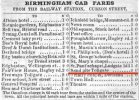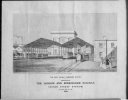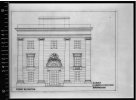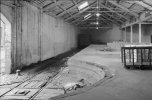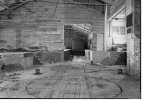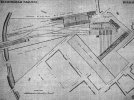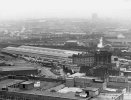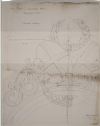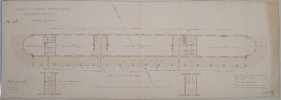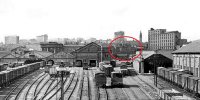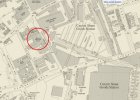-
Welcome to this forum . We are a worldwide group with a common interest in Birmingham and its history. While here, please follow a few simple rules. We ask that you respect other members, thank those who have helped you and please keep your contributions on-topic with the thread.
We do hope you enjoy your visit. BHF Admin Team
You are using an out of date browser. It may not display this or other websites correctly.
You should upgrade or use an alternative browser.
You should upgrade or use an alternative browser.
DavidGrain
master brummie
The Turnpike trusts were abolished in 1888 so the reference to toll gates would imply before this date but locals might have continued to refer to the location of toll gates after this date
Lloyd
master brummie
The track far right is triple gauge, were they 4'8½" (British standard), 5'3" (Irish standard) and 7'¼" (Great Western broad) gauges?A print of Curzon Street , Titled ‘The First Railway Passenger Station in Birmingham (1838) source Historicengland.org.uk
That is the only conclusion that I could come to, but cannot find any evidence that the GWR, ever ran Broad gauage into Curzon St. There were parliamentary bills to this effect, and the Duddeston viaduct was built with this in mind, but never completed. I wonder if this was artist's licence
Lloyd
master brummie
Forget it ! I was looking at an enlarged version which hid the fact of two tracks crossing in the foreground! All are normal 4'8½" gauge tracks.That is the only conclusion that I could come to, but cannot find any evidence that the GWR, ever ran Broad gauage into Curzon St. There were parliamentary bills to this effect, and the Duddeston viaduct was built with this in mind, but never completed. I wonder if this was artist's licence
Covroad
master brummie
izzy eckerslike
yow've med my day yaw av
I spent hours in there in the 1950's, dad used to deliver BR parcels in Rubery & Barnt Green area and in the school holidays I often used to go with him. While he sorted out the order of the parcels at Curzon St I used to wander around, I remember gigantic curtains that could be used to block out the weather on the huge doorways, some let the daylight through and others were solid tarpaulins
I remember one foggy winter morning I wandered further than usual and vividly remember looking through a gap and seeing a whole row of ghostly looking disused steam engines with cow scoops on the front, like the wild west engines, maybe used for clearing heavy snow off the tracks?
I remember one foggy winter morning I wandered further than usual and vividly remember looking through a gap and seeing a whole row of ghostly looking disused steam engines with cow scoops on the front, like the wild west engines, maybe used for clearing heavy snow off the tracks?
Last edited:
Heartland
master brummie
In the Science Museum of images of Curzon Street there is one captioned Curzon Street Viaduct. Not all the plans there were carried forward and this one seems not to have happened and the London & Birmingham Railway build a level crossing instead to reach their goods yard
DavidGrain
master brummie
Can you give us more details please as this sounds as if it might be the viaduct from Bordesley which was never completed.In the Science Museum of images of Curzon Street there is one captioned Curzon Street Viaduct. Not all the plans there were carried forward and this one seems not to have happened and the London & Birmingham Railway build a level crossing instead to reach their goods yard
Heartland
master brummie
in 1841 the Grand Junction Station buildings faced Curzon Street whilst the London & Birmingham building had its entrance from New Canal Street. Camp Hill Station, Birmingham & Gloucester Railway was also in existence by then. The railway from Camp Hill to Join up with the London & Birmingham Railway was opened August 17th, 1841 when Camp Hill became a goods station.
Heartland
master brummie
As work proceeds HS 2 there is still the lack of recognition in these modern times that there were two stations at Curzon Street; the London & Birmingham Station and the Grand Junction Station. Whilst traffic was exchanged at Curzon Street between the two railway companies they had their own agendas. As new schemes came into existence some would favour the Grand Junction and others the London & Birmingham if they intended to join with their separate routes. One such scheme led to the building of the Bordesley Viaduct as part of the Birmingham & Oxford Junction Railway. That scheme joined with the Grand Junction Railway at Curzon Street. When the Grand Junction and London & Birmingham railway merged into the London & North Western Railway priorities changed and although built the Bordesley Viaduct never saw a train from the Curzon Street end and simply had tracks associated with the goods station which was Great Western Railway
DavidGrain
master brummie
The original entrance to the London and Birmingham Curzon Street station was to the left of the still standing building which was a hotel in the early days. The entrance to the Grand Junction station was along Curzon Street.As work proceeds HS 2 there is still the lack of recognition in these modern times that there were two stations at Curzon Street; the London & Birmingham Station and the Grand Junction Station. Whilst traffic was exchanged at Curzon Street between the two railway companies they had their own agendas. As new schemes came into existence some would favour the Grand Junction and others the London & Birmingham if they intended to join with their separate routes. One such scheme led to the building of the Bordesley Viaduct as part of the Birmingham & Oxford Junction Railway. That scheme joined with the Grand Junction Railway at Curzon Street. When the Grand Junction and London & Birmingham railway merged into the London & North Western Railway priorities changed and although built the Bordesley Viaduct never saw a train from the Curzon Street end and simply had tracks associated with the goods station which was Great Western Railway
As Heartland says above it is not generally realised that there were two separate stations in the same way that few people today realise that New Street was two separate stations prior to 1923 with the London and North Western station on one side of Queens Drive and the Midland station on the other side.
paul stacey
master brummie
I have stated on this thread before, that as a lad , I worked for a couple of weeks, at the Curzon Street goods yard. Back then it had not changed from the early Victorian times,except for the 3 wheel lorry's and cars, all the buildings were magnificent structures, and many, many, horses. Sad they demolished all of them, acres of cobbled streets and yards, I can see them now nearing 80!!
Heartland
master brummie
Snow Hill was initially the junction between the Birmingham Wolverhampton and Dudley Railway and the Birmingham & Oxfords Junction Railway although both became part of the GWR mixed gauge route as construction proceeded to make the first Snow Hill station
The original LNWR station at New Street also served other railways
In these early times several stations in the West Midlands had more than one operator working through it
Wolverhampton had two joint stations
Queen Street or High Level had the Shrewsbury & Birmingham and the Stour Valley Railway LNWR
The Low Level (Mixed Gauge) Station had the Birmingham, Wolverhampton and Dudley (GWR) and the Oxford Worcester and Wolverhampton Railway and later with the making of the GWR Wolverhampton Junction Railway, the Shrewsbury & Birmingham
The original LNWR station at New Street also served other railways
In these early times several stations in the West Midlands had more than one operator working through it
Wolverhampton had two joint stations
Queen Street or High Level had the Shrewsbury & Birmingham and the Stour Valley Railway LNWR
The Low Level (Mixed Gauge) Station had the Birmingham, Wolverhampton and Dudley (GWR) and the Oxford Worcester and Wolverhampton Railway and later with the making of the GWR Wolverhampton Junction Railway, the Shrewsbury & Birmingham
MWS
from Bham
Always interesting. Had to pause it a couple of times just to get my bearings, too many different viaduct names.
It would be nice to have a drone fly along the route from Curzon St to Water Orton to get a sense of the progress. I would also have liked to know if they are on schedule, especially with Aston Church Road.
It would be nice to have a drone fly along the route from Curzon St to Water Orton to get a sense of the progress. I would also have liked to know if they are on schedule, especially with Aston Church Road.
DavidGrain
master brummie
Water Orton to Washwood Heath is underground in what is known as the Bromford TunnelAlways interesting. Had to pause it a couple of times just to get my bearings, too many different viaduct names.
It would be nice to have a drone fly along the route from Curzon St to Water Orton to get a sense of the progress. I would also have liked to know if they are on schedule, especially with Aston Church Road.
Latest info of progress is on
I have heard that
Mary Anne (Tunnel Boring Machined always have female names) is said to have 40m to go
Elizabeth has 2160m to go as about a week ago.
boilerman
master brummie
I worked at the, then, Public Works Department, (the council) in Curzon St. Starting in 1967. Next door to the depot was the "banana yard" an old store yard literally for bananas, a long time before it was taken over by the council, as a store place.
About that time was a pub called, The Railway. A great place for dinner times, and even better in the evenings for bands.
About that time was a pub called, The Railway. A great place for dinner times, and even better in the evenings for bands.
paul stacey
master brummie
Yes, boilerman, Great pubs, from a great time,sadly now all gone !!
I recall the hosing department took all of its fleet vehicle to Curzon St depot for the servicing ad maintenance. I do also recall the Railway pub, famous for some of the bands who played there. The landlord was a legendary pool player too.I worked at the, then, Public Works Department, (the council) in Curzon St. Starting in 1967. Next door to the depot was the "banana yard" an old store yard literally for bananas, a long time before it was taken over by the council, as a store place.
About that time was a pub called, The Railway. A great place for dinner times, and even better in the evenings for bands.
DavidGrain
master brummie
There was a Goods Station on the opposite side of Curzon Street from the former passenger station. There was a level crossing across Curzon Street, I believe the only level crossing in Birmingham. It could be a photo from there.This is labelled as British Rail Goods Depot Curzon Street. Obviously, the remains of the depot, rather than the depot. I am not clear exactly where this was taken . Looks like a building like a school behind it.
View attachment 211159

